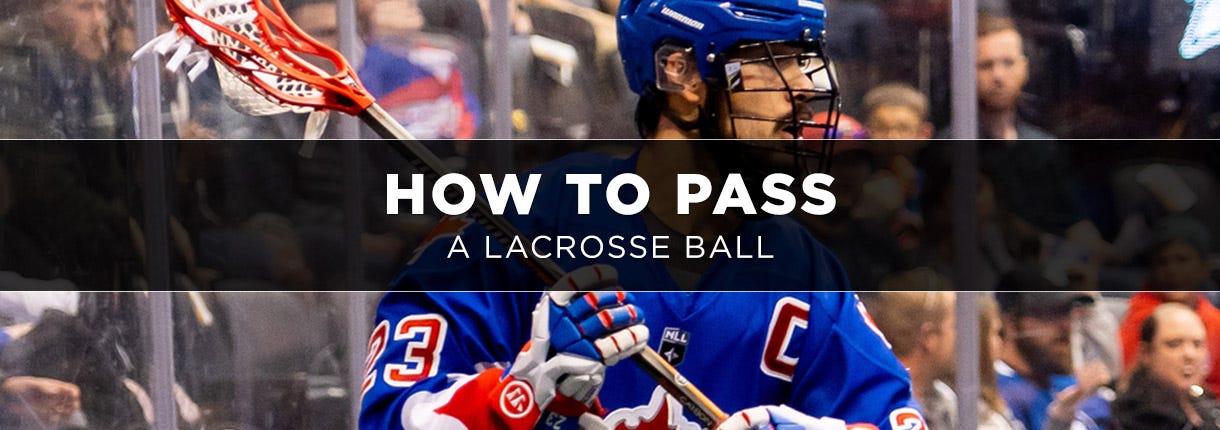Lacrosse Passing Guide: How to Throw a Lacrosse Ball

Knowing how to pass is key to becoming a great lacrosse player. Lacrosse passing is an integral part of the game - it lets the offense advance towards their goal, and is something all players should practice to improve their game.
- Steps to Passing a Lacrosse Ball (jump link to H2 below)
- Lacrosse Pass Techniques (jump link to H2 below)
- Lacrosse Pass Tips and FAQs (jump link to H2 below)
Steps to Passing a Lacrosse Ball
- Gripping the Lacrosse Stick: Before throwing a lacrosse ball, players should position their hands on the stick for proper control and force of the lacrosse pass. The bottom hand should grip the handle of the shaft, and the top hand should be near the midway point between the handle and the head of the lacrosse stick.
- Lacrosse Passing Stance: When learning how to pass in lacrosse, it’s important to understand that foot positioning is a key in knowing how to throw a ball accurately. A right-handed lacrosse player will want to have their left foot forward when beginning the lacrosse throw. The knees should be shoulder width apart. The reverse is true for left-handed players passing the lacrosse ball.
- Pulling Back the Lacrosse Stick: To begin a lacrosse throw, you’ll want to pull the stick back with your top hand and point your forward elbow to where you want to throw the lacrosse ball. Pointing your elbow at your target is an important element in learning how to throw a ball accurately.
- Step and Release: The final step in lacrosse throwing is stepping forward and releasing the lacrosse throw. Step forward with your front foot and focus on the target of your lacrosse pass. Using your top arm, bring the head of the lacrosse stick forward to release the lacrosse throw.
Lacrosse Pass Techniques
The four-steps that outline how to throw lacrosse balls is a general rule of thumb for a standard pass, but there are several advanced lacrosse passing techniques to learn. If you’re looking to grow into a more advanced lacrosse player, working on how to pass lacrosse balls in different situations will go a long way in growing your game and becoming better at throwing a lacrosse ball.
Behind the Back Pass
The behind the back pass, sometimes called a lacrosse back pass, starts in reverse of a standard lacrosse throw. You’ll start with your stick forward instead of over your shoulder, and then wrap the stick around your side, releasing the lacrosse pass behind your back.
Flip Pass
If you only need to make a short lacrosse pass, the flip pass is great for knowing how to throw a lacrosse ball accurately to a nearby teammate. The flip pass starts with the lacrosse stick in front of you, parallel to the ground. It ends with a quick flick of the front of the stick to release the lacrosse throw over a short distance.
Bounce Pass
The bounce pass is an effective option if there’s a defender between you and the teammate you’re trying to get a lacrosse pass to. The lacrosse bounce pass uses the same form as a standard pass, but the lacrosse throw is released late in order to bounce the ball under the defender’s stick.
Over the Shoulder Pass
The over the shoulder lacrosse pass used when moving the ball up the field or when clearing out or the defending zone. The thrower of the over the shoulder lacrosse pass releases the ball early, giving the pass more height and allowing the receiver to catch the ball over their shoulder in stride to keep forward momentum.
Sidearm Pass
If you’re looking to find a new angle to make a lacrosse pass with a defender close in front of you, the sidearm pass is a great option if you’re wondering how to throw a lacrosse ball around another player. The sidearm lacrosse throw involves a lacrosse throw parallel to the ground on the side of the player rather than overhead while sliding the top hand down towards the butt end of the stick.
Underhand Pass
The underhand lacrosse pass is often used to throw a lacrosse ball around a close defender when contact is made. This lacrosse throw is slower than other lacrosse passes, but using an underhanded motion can sometimes be the best way to throw under a defender’s arm during a check.
Lacrosse Pass Tips & FAQs
How do I pass more accurately in lacrosse?
If you’re trying to learn how to throw a ball accurately, the best way is to focus on proper form and practice. Beginners should concentrate on maintaining a perfect form for a standard lacrosse throw and getting as many repetitions in as possible to make form a habit.
How do you throw a long pass in lacrosse?
To make a long lacrosse throw, you’ll want to take a larger step into the standard lacrosse pass and release the ball slightly earlier than you would on a normal pass. A strong step and throw, combined with an early release, will result in more distance from your lacrosse pass.
How do you catch a lacrosse pass?
In order to catch a lacrosse throw, you should choke up on the lacrosse stick with your top hand close to the head. While looking the lacrosse throw into the basket, make sure you keep a loose grip on the stick to have enough give to allow the ball to settle into the net.
Is there offsides in lacrosse?
Yes. Lacrosse offsides occurs when there are too many players across the restraining lines or exceeding the total number of players on the field during line changes.






Login and Registration Form
or
Create an account